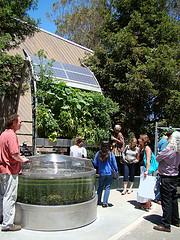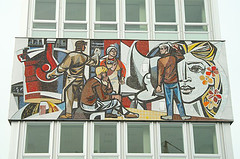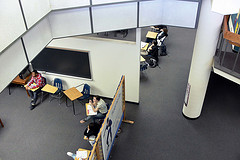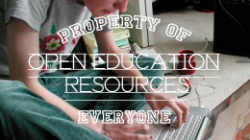Green OER
In 2010, ISKME partnered with Agro-Know to create OER Commons Green. The site creates a unique lens on environmental and sustainability-related learning resources within ISKME's renowned open learning network OER Commons. OER Commons Green aggregates best-in-class green open educational resources on topics like climate change, pollution, and eco-culture from diverse providers around the globe.
OER Commons Green was jointly developed by ISKME and Agro-Know, using a global team of e-learning metadata specialists. The team iteratively co-designed a vocabulary for categorizing green learning resources and collaboratively developed all aspects of the site.

CyberInfrastructure-TEAM Implementation Project: The Signal Processing Education Network
As external evaluator for the project, Collaborative Research: CI-TEAM Implementation Project — The Signal Processing Education Network, ISKME formatively and summatively evaluated the project’s efforts to support a network of teachers, students and practitioners who collaboratively explored dynamic Signal Processing (SP) content as they worked to model real world science and engineering behaviors and inquiry-based teaching and learning practices.
ISKME aimed to inform the project by examining how teachers and learners use, adapt, create, and evaluate SP resources and draw upon other network members in the process. Also assessed were the project’s impact on teaching and learning and its implications for scaling the SP Education Network model to other contexts, subjects and disciplines. The research goals were manifold. First, it sought to shed light on how the Signal Processing Education Network model is aligned to new teaching and learning practices for participating faculty and students. It also sought to inform the ways in which the SP Education Network model contributes to the engineering discipline, and conversely, what engineering as a discipline contributes to the model. Finally, the research attempted to provide insights into the ways that knowledge sharing occurs, types of knowledge shared, and the role of knowledge sharing in enhancing teaching and learning practices.
Data collection included interviews with project leaders, a baseline survey of faculty to assess extant teaching practices and perceptions, a baseline survey of existing SP content and its use, surveys of faculty and student participants to asses changes in teaching and learning perceptions and practices, analysis of artifacts on the SPEN and DSP community sites, and use analysis of activity on associated project sites. Data collection also included grades and enrollment and retention data for students to provide indications of the impact of the project on student learning, achievement and persistence.

-
How and the extent to which the project’s Signal Processing content is created, shared, reused and evaluated by teachers, students, and other network community members.
-
The extent to which new teaching and learning practices are inspired and implemented as a result of participation in the Signal Processing Education Network.
-
The perceived impact of the Signal Processing Education Network and associated content, tools and processes on the role of teachers and learners, and on teaching and learning practices generally.
-
The successes and challenges of engaging in the Signal Processing Education Network, and the supports that best facilitate engagement by participants.
-
How the project’s education network model benefits engineering as a discipline, and how it might be scaled to other subjects and disciplines.
Completion Matters

Leadership Connection for Justice in Education - Griot Project
The Griot project, an initiative of UC Berkeley's Leadership Connection for Justice in Education, seeks to support veteran school leaders in becoming griots, or messengers and actors of change who can re-imagine and reform urban schools to meet the needs of their diverse student bodies. As a thought partner in this initiative, ISKME has collaboratively developed an evaluation framework to promote and sustain the transfer of learning for leaders.

Science Collaborator: Open Participatory Learning Infrastructure for Education (SCOPE)
As an innovative approach to faculty professional development, SCOPE was an NSF-supported exploratory project led by BioQuest that investigated the development and use of Problem Spaces with respect to 1) their utility as a focus for faculty teaching scholarship; and, 2) their potential impacts on students' biological problem solving skills. Introductory biology faculty from disparate institutional settings collaboratively developed online curricular resources and strategies to support students' work on contemporary scientific investigations.
As a project partner, ISKME contributed to the development of a "collaboratory" framework focused on bridging the project's goals of participatory learning, teacher collaboration, and OER content creation and use. The framework was then implemented in a series of workshops with SCOPE participants. In addition, ISKME aggregated new and existing Problem Spaces on its OER Commons site. These collaboratively created resources offered community-built access to current scientific data, strategies, and tools for both the teacher and their learners as they engaged in exploration of contemporary science problems.

San Francisco Unified School District Leadership Development Initiative
In 2008, ISKME conducted a one-year evaluation study to inform and support the success of the Leadership Initiative, a collaborative partnership between the San Francisco School Alliance (SFSA), San Francisco Unified School District (SFUSD), UC Berkeley (UCB), and Partners in School Innovation (PartnersSI). The Leadership Initiative was formed to facilitate leadership development in SFUSD, and sought to transform the way school leaders are recruited, prepared and supported throughout their careers.

UC Berkeley's Strategic Leadership Collaborative (School Leadership Program)
The Leadership Connection for Justice in Education (LCJE) at the University of California, Berkeley offers complement of programs that support leaders at several stages of their leadership career. Specifically, LCJE has established four pathways to effective leadership development: 1) identification and recruitment of aspiring leaders, 2) leadership preparation, 3) induction and retention, and 4) research and best practice sharing.
In an effort to help LCJE understand the requirements and implications of enhanced support for its partner districts, ISKME conducted a study that included in-depth interviews with 18 top-level district administrators from LCJE’s partner districts. The purpose of the interviews was to shed light on how the districts define leadership; how they understand and assess their existing leadership pathways and practices; and how they view the role of the university in supporting their leadership development needs. As such, the two key goals of the study were to identify collaborative support mechanisms and practices that could inform the development of services offered by LCJE to more effectively align itself with district leadership development needs; and to forward the conversations between LCJE and its districts in a way that would help identify the places where LCJE could make a positive impact on its partner districts’ leadership practices.

Online Teaching and Learning in Developmental Education: An Instructor Perspective
Despite the upsurge in online developmental education course offerings in recent years, there is a dearth in knowledge on the optimal context to support such courses, and on how they are being taught, perceived and experienced by instructors. This study sought to explore how online developmental education courses are being taught, who is teaching them, and what factors, practices, and supports play a role in online teaching and learning.
The study roots its analysis in the instructors who teach developmental education online, specifically through the examination of their experiences, practices, and perceptions around online teaching and learning. In doing so, it seeks to inspire new avenues for research and knowledge on online instruction of developmental education courses, which can in turn serve as a catalyst for innovations in online developmental education in the face of growing demand.

The study revealed that instructors of online developmental education are well-trained in online technologies, and while they are concerned about the potential lack of institutional supports and student pre-requisite knowledge for online courses, they proactively seek out mechanisms to overcome these obstacles. Furthermore, although instructors of online developmental education expressed concern about whether their students possessed the necessary pre-requisite skills to succeed in online courses, they placed less emphasis on the importance of face-to-face communication than their counterparts who teach in face-to-face formats only. Instead, they appeared to seek out or instill mechanisms to overcome the lack of face-to-face contact, including sending personalized, frequent emails of encouragement to students, creating open, threat-free bulletin board environments, and supplementing online content with instructor-voice recordings.
Connexions: Author Use and Reuse of Open Educational Resources
For teachers and learners, the proliferation of Open Educational Resources (OER), along with advances in information technologies, has meant centralized access to materials and the possibility of creating, using, and reusing OER globally, collaboratively, and across disciplines. Focusing on the repository Connexions (www.cnx.org), this study examined how and to what extent OER are created, adapted and augmented by both individuals and communities of author users.
Connexions log file data from April 2000 to July 2005 were analyzed. Examination – in the form of frequencies, correlations, probability and qualitative analyses – allowed for the quantification and qualification of OER use and reuse behaviors and provided insight into the factors that support these behaviors. Also, because Connexions allows author users to enter comments about why they augmented and published OER content, data allowed for the analysis of the reasons for creating content, and user perceptions of that process. Because the focus was to better understand aspects of author use and reuse that center around content creation, augmentation, and collaboration, the analysis was confined to CNX users who have created, augmented and contributed OER content to Connexions.
These users are referred to in this study as ‘author users.’ After the log file analysis was completed, eleven follow-up phone interviews were conducted in order to contextualize the findings from the log file analysis from the perspective of specific author users. The goal of the interviews was to understand obstacles to and incentives for content creation, use, and reuse. The interviewees were selected based upon the frequency and type of activities that they participated in – the objective being to have a diverse mix of participants with varying levels of use and types of activities. The questions posed to the eleven participants centered on why they chose to use Connexions, their typical activities, and their prior experiences with creating and using OER. Thus, while the quantitative data provided insight into use and reuse practices, as well as into some of their determinants, the interviews conducted with the selection of author users added depth to these findings by delving into the why and how behind use and reuse practices, as well as into the discontinuation of use and reuse by some users.

The study indicated a 70% annual growth in new Connexions authors over the nearly five-year period, and that author users edited and augmented existing content to a greater extent than they created new content. The study further found that author group size was central to retaining active, consistent users. Specifically, as group size increased beyond one author user, the probability that users stayed with the OER collection increased with it. However, given that the majority of the OER content within this study was created individually as opposed to in groups, the issue becomes how OER repositories can facilitate more group authorship (or participation). In facilitating group authorship, group role structures and assignation of roles were found to play an important role.
- How and to what extent are OER created, adapted, augmented, and ‘remixed’ by both individuals and communities of author users?
- What role do author workgroups play in the sustainability of OER?
- What infrastrustructural tools and mechanisms can best support OER repositiry users in contribuiting, using and reusing OER?
Building and Sustaining Community Capacity for Civic Engagement, Leadership and Advocacy
ISKME conducted an independent study of KaBOOM! on the community impact of building play spaces. The project looked at how community-build processes and sites are impacting children and their parents, the community organizations and funding organizations involved (community partnerships and corporate citizenship), and the larger communities within which the play spaces were situated.
Data collection consisted of pre-visit interviews, a two-day site visit to each of the ten selected sites and meetings with commuity and corporate partners, members of the planning committee, volunteers and team leaders for the community build day, as well as current parent, child, and teacher users. This also included a survey of playground impact on children, a partnership survey, observations and photo documentation of the playground itself, and a "windshield" survey of each community (which consisted of a 45-minute drive with one or more community members through the local neighborhood that the playground served).

Site visits and surveys revealed strong evidence of the expansion of play opportunties for low-income children, and the majority of parents and teachers survey believed that the playground had significantly impacted the physical development of children. The playground was also reported to build increased community pride, and had resulted in a decrease in vandalism and theft in the immediate area. The build process itself resulted in an increase in collaboration among diverse groups and organizations, and demonstrated the postive impact of community partner and funding partner matching and relationship building, as well as served as a successful model of civic engagement.

